University faculty, staff and students must properly manage or dispose of all waste materials in accordance with university, local, state and federal policies and regulations. The Environmental Protection Agency (EPA) and the Virginia Department of Environmental Quality (VADEQ) closely scrutinize academic institutions and personnel. Improper disposal of waste can result in citations and fines for the university and fines and possible imprisonment for the individual.
All this talk of fines is unnecessary, however, because UVA maintains a user-friendly waste disposal program. Environmental Health & Safety (EHS) answers waste collection questions and picks up your chemical waste upon request, free-of-charge. Take the time to follow the simple guidelines below, and call EHS if you have any questions.
View our "Hazardous Waste Compliance Video" (45 seconds).
NEVER put hazardous waste down the sink or in the trash. If you are not sure if a chemical is hazardous, contact EHS.
EHS provides the following containers for chemical waste collection, activities requiring special containers are evaluated on a case-by-case basis.
All chemical waste containers must remain CLOSED (capped) except when waste is being added—this is a regulatory requirement. Additionally, when chemical waste containers are left uncapped, laboratory personnel are at the risk of chemical exposure due to inhalation of chemical vapors.
It is very important that the waste container is made of a material that is compatible with the waste to be put in it. Do not put acidic or basic waste (pH <3 or >9) in metal cans. Metal cans corrode in a very short time.
These containers are provided by EHS for regular use. We will deliver these to you upon request.
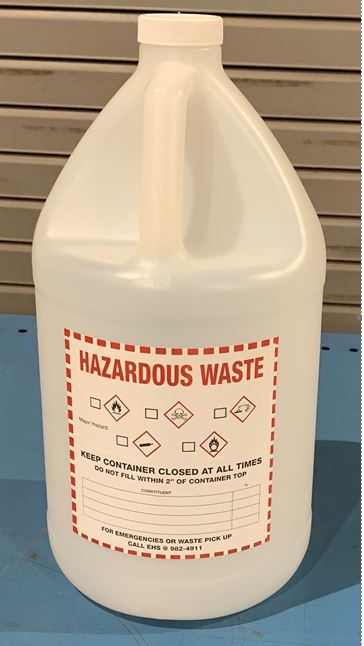
Bottle, plastic, 4-liter (~1 gallon)
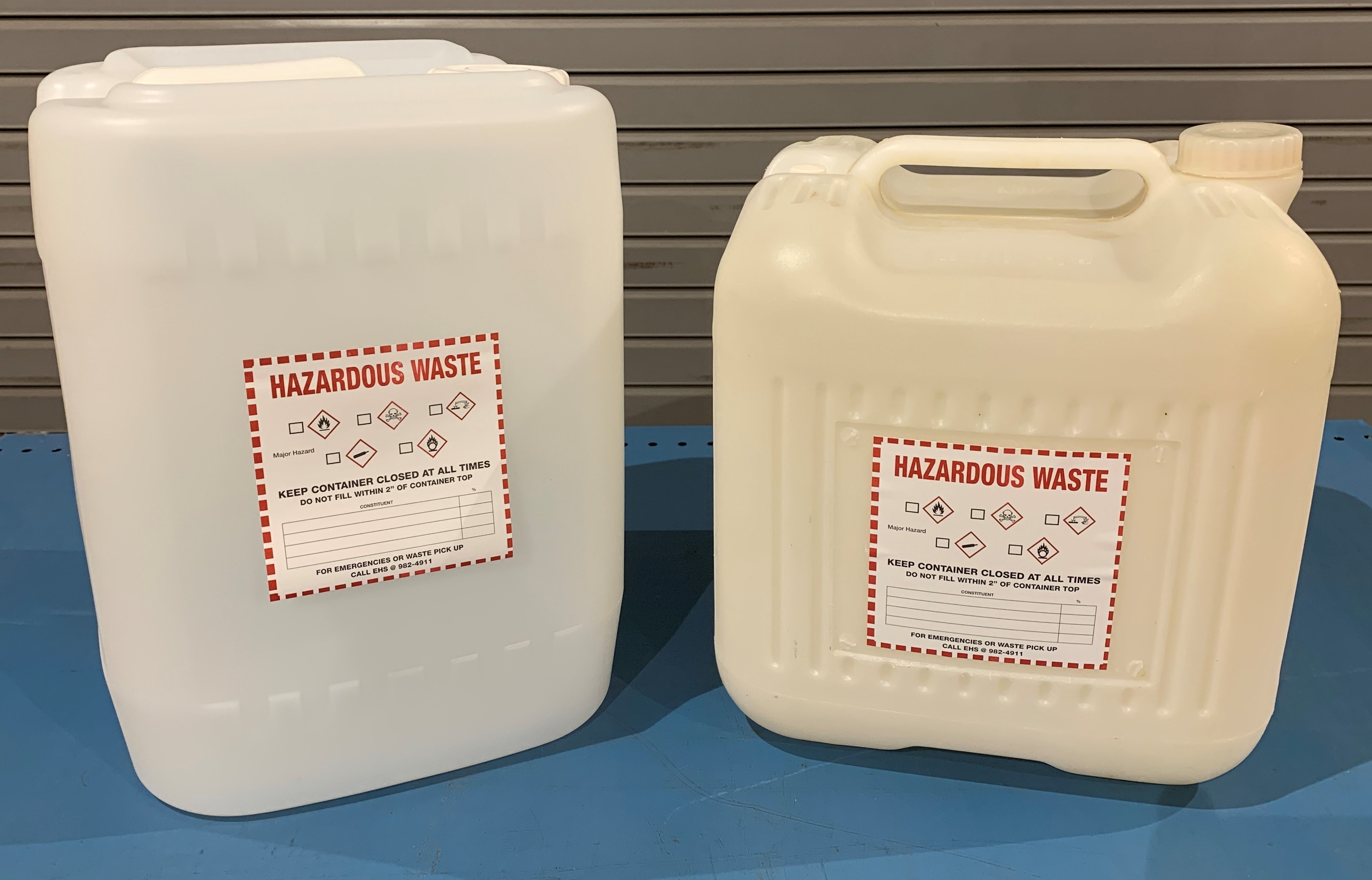
Carboys, plastic, 5-gallon - tall or square
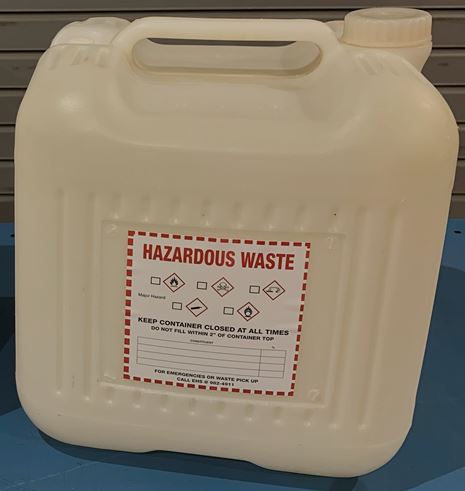
Carboy, plastic, 5-gallon - square
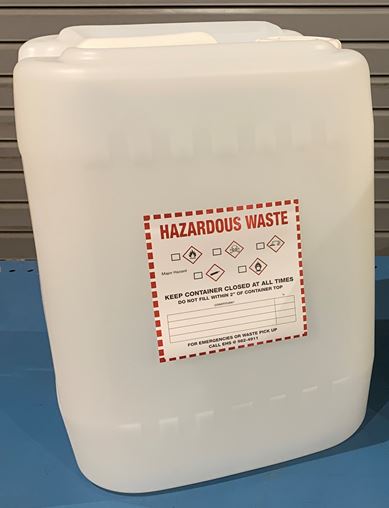
Carboy, plastic, 5-gallon - tall
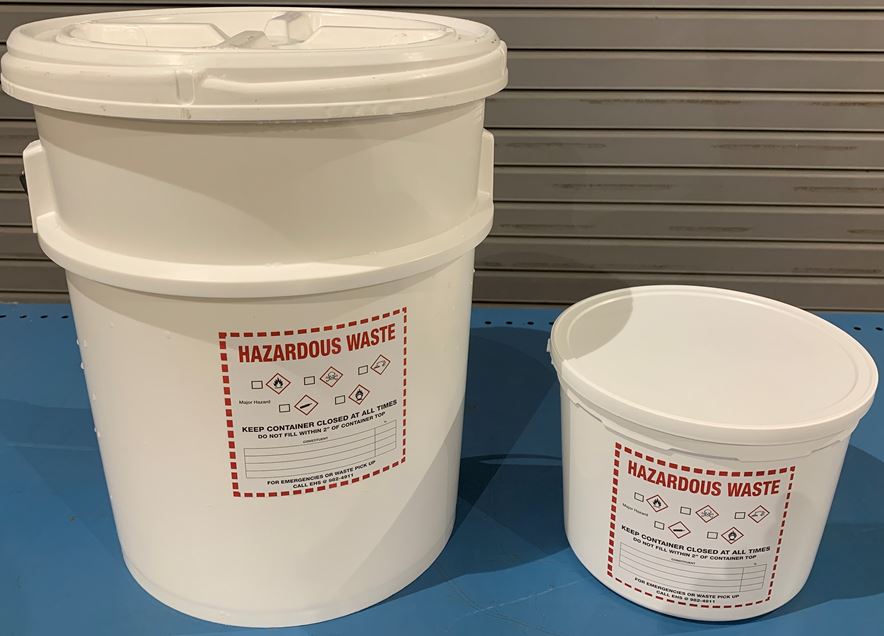
Buckets, plastic, 5-gallon & 1 gallon
Liquid waste should NEVER be put in these containers.
Buckets are used for solid and gel waste (including ethidium bromide contaminated gels).
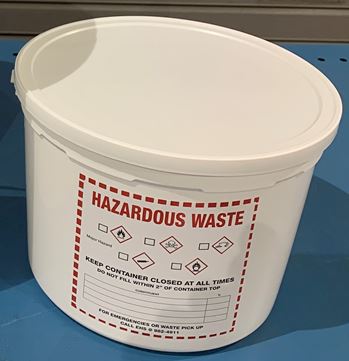
Bucket, plastic, 1-gallon
Liquid waste should NEVER be put in this container.
Buckets are used for solid and gel waste (including ethidium bromide contaminated gels).
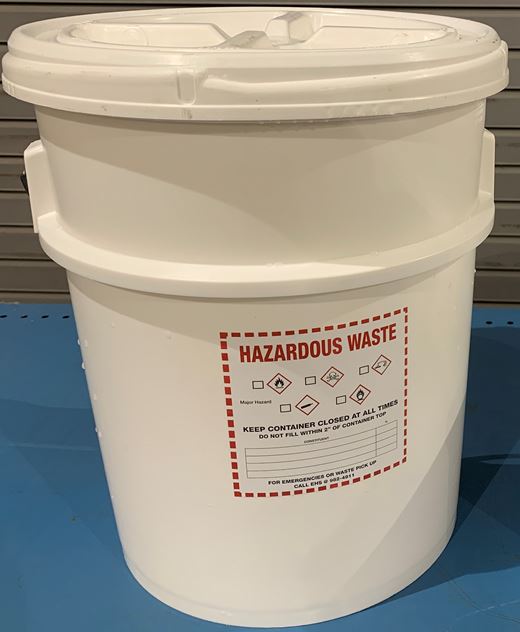
Bucket, plastic, 5-gallon
Liquid waste should NEVER be put in this container.
Buckets are used for solid and gel waste (including ethidium bromide contaminated gels).
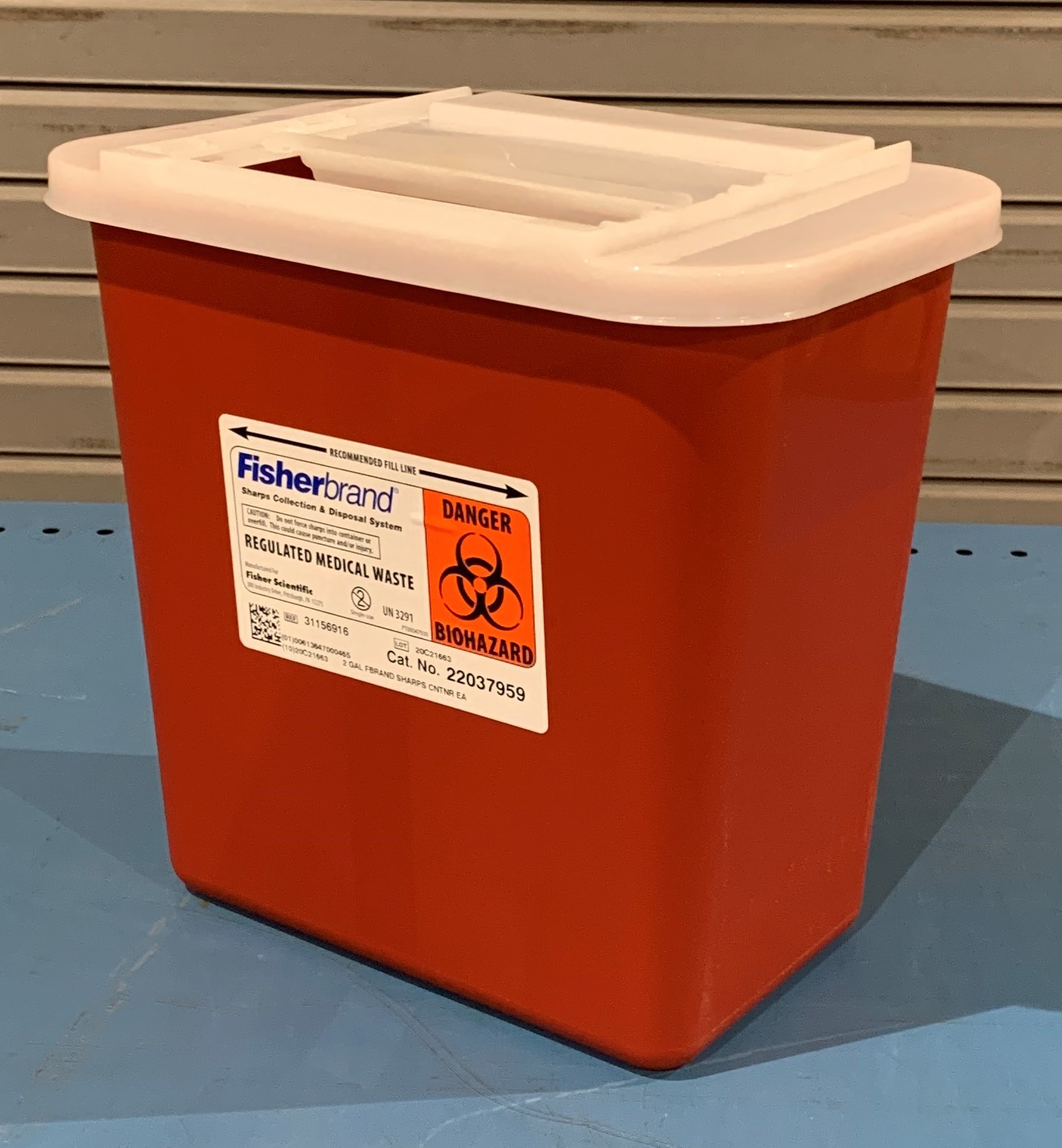
Sharps, red, 2-gallon
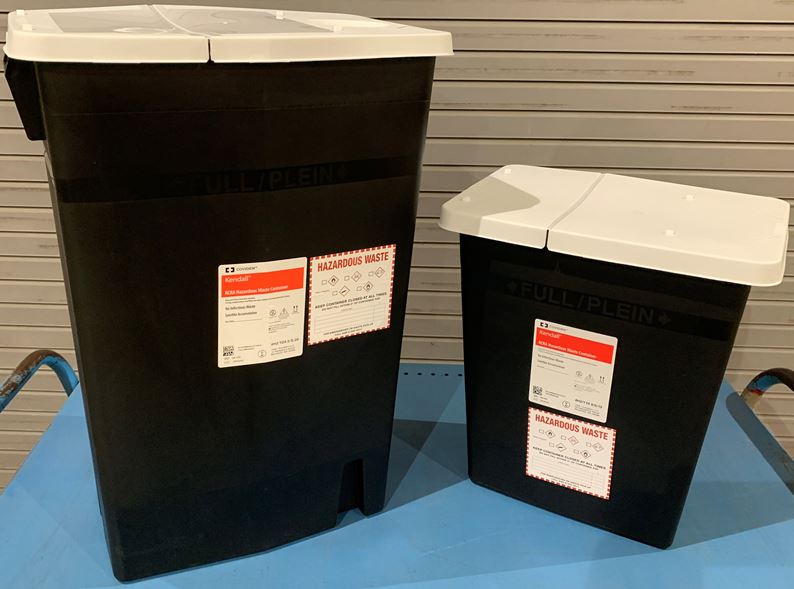
Sharps, black, 18-gallon & 8-gallon
For use ONLY in Patient Care Areas!
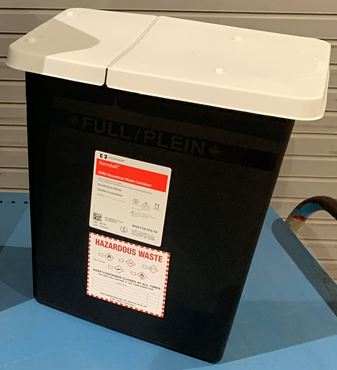
Sharps, black, 8-gallon
For use ONLY in Patient Care Areas!
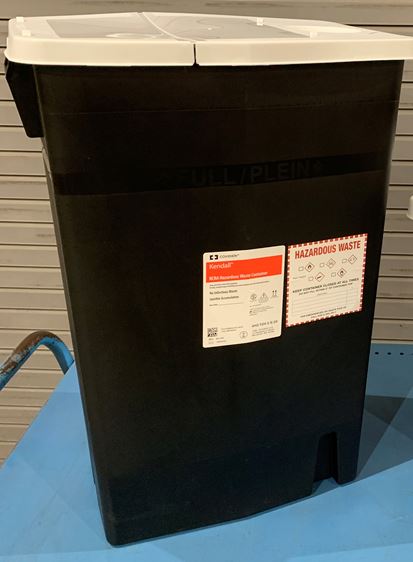
Sharps, black, 18-gallon
For use ONLY in Patient Care Areas!
View our "Hazardous Waste Compliance Video" (45 seconds).
On April 8, 2018, the Commonwealth of Virginia adopted the Environmental Protections Agency's (EPA) Hazardous Waste Generator Improvements Rule. One major change this new regulation brings is more stringent labeling requirements for hazardous waste.
Previously, a container of hazardous waste needed to be labeled with either the words "Hazardous Waste" or a description of the contents of the container (e.g. "methanol", "flammable solvents").
The new regulations require containers of hazardous waste to be labeled with the words "Hazardous Waste" AND a description of the contents of the container.
In order to make compliance with these new requirements as easy as possible, EHS has redesigned UVA's Hazardous Waste Stickers, an example can be seen below.
This new sticker provides space on which to write the contents of the container and to select (check) the appropriate Globally Harmonized System (GHS) pictogram. The example below shows proper labeling for a flammable solution.
When filling out the stickers be sure to select the appropriate GHS pictogram AND to include the contents of the container.
These changes do not affect the requirement to fill out an EHS Waste Disposal Ticket for each container of waste prior to pickup.
Hazardous Waste Sticker (see pic)
View our "Hazardous Waste Compliance Video" (45 seconds).
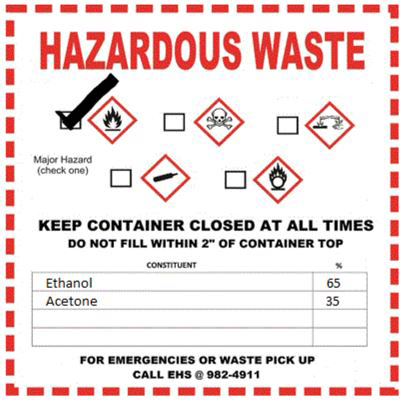
In addition to waste stickers, all waste containers MUST have a Waste Disposal Ticket (see image below), affixed to it prior to pick up. This label is issued by EHS. This includes chemicals still in their original containers. Waste will not be picked up if it is not labeled properly. If you need new labels, let us know and we will deliver them. The label should be affixed to the waste container by a single piece of tape across the top of the label.
Waste Disposal Tickets must be filled out completely. This includes:
Waste Disposal Ticket (see pic)
View our "Hazardous Waste Compliance Video" (45 seconds).
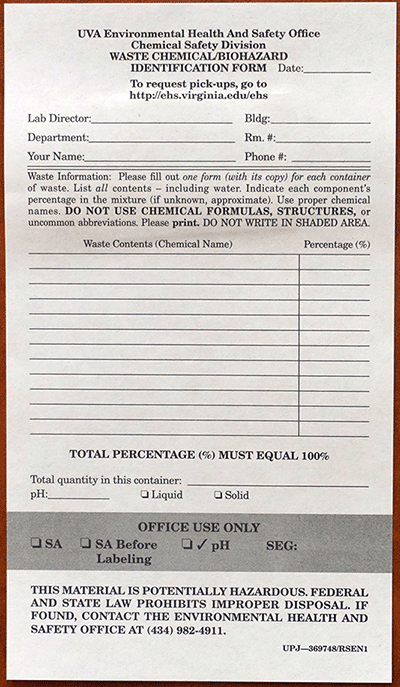
In order to minimize the chances of incompatible materials being mixed together and to keep disposal costs for the University as low as possible, we ask that you keep certain types of chemicals separated at the time of collection. When combining different materials, always check the SDS to be sure they are compatible materials, or call EHS for guidance.
Hazardous Waste Collection Guidelines for persons generating/collecting Hazardous (Chemical) Waste in NON-laboratory areas can be found here.
Keep the following groups in separate containers whenever possible and use the associated GHS pictogram to identify the hazard on the waste label when applicable.

-Non-halogenated organic solvents, <5% water
-Non-halogenated organic solvents, >5% water

-Halogenated solvents (% water unimportant)
-Isoflurane should be blended with other halogenated solvents.
-Cyanides
-Formaldehyde Solutions
-Solutions containing compounds of the following metals: arsenic, barium, cadmium, chromium, lead, silver and selenium.
-Any solution containing mercury or its compounds. Mercury and mercury compounds should be kept separate from any liquid whenever possible.
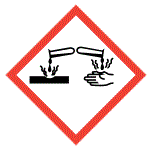
-Acids, organic
-Acids, mineral
-Bases, organic
-Bases, mineral
-Photographic stop bath
-Note: Do not put acidic or basic waste (ph <3 or >9) in metal cans. Metal cans corrode in a very short time. Keep acids and bases separate from hydrocarbons and ethers.
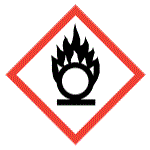
-Inorganic oxidizers
-Organic peroxides
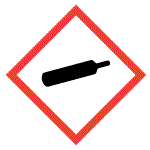
-All aerosol cans
-Note: A recent change in the Virginia Hazardous Waste Regulations requires that all unwanted aerosol cans be collected as Hazardous Waste.
-Photographic fixer
-Photographic developer
-When possible, keep carcinogens, mutagens, and teratogens separate from other wastes
-Keep aqueous wastes separate from organic solvents
-Keep halogenated and non-halogenated wastes separate
-Sulfides
-Pesticides
-Paints
-Oils
-Lamps/Bulbs - Fluorescent lamps and high intensity discharge bulbs contain mercury and must be recycled. Facilities Management should handle any bulbs from the lighting systems of buildings as part of general maintenance. Smaller bulbs from laboratory equipment can be given to EHS for disposal.
-Batteries - EHS will take lithium batteries, and damaged/defective batteries. UVA Recycling accepts lithium, lithium ion, lithium rechargeables, lead acid, alkaline, nickel cadmium, nickel metal hydride, 9 volts, and button batteries.
-All sharps (Needles, razor blades, scalpel blades, etc.), whether they are contaminated with trace chemicals or uncontaminated, must be placed in a sharps container.
See our biological waste page for additional guidance. Always use the sharps container with the top in place. Sharps container are available from EHS via our pickup & disposal request page. Avoid using sharps containers for uncontaminated glass. See our waste laboratory glassware guidance (WLG).
If they DO NOT contain or ARE NOT contaminated with Radioactive Material (any amount), Chemicals (more than a trace amount) or Biohazardous Material (any amount), then these waste materials are Waste Laboratory Glassware (WLG).
Waste Laboratory Glassware:
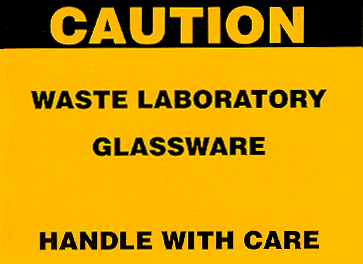
Empty Container Disposal: EHS does not pick up empty chemical reagent bottles, and neither does UVA Recycling.
Triple rinse empty chemical bottles, collect the rinsate as waste, deface the chemical label, and then discard bottles in the trash or reuse for waste collection (labelled appropriately).
If reusing an empty container for waste collection, it is advisable to ONLY use the empty container for a similar and compatible material as compared to the original contents! For example, use an empty ethanol bottle for non-halogenated solvent waste collection. Chemical reactions, leading to bottle explosion, have occurred when using empty plastic alcohol bottles for acid waste, even after rinsing!
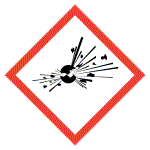 Ethers tend to form extremely explosive compounds over time. Therefore, date all ether cans. Do not keep an open ether can for more than 1 month or an unopened can for more than 12 months. If you have an old ether can, label as waste and call EHS for pick up.
Ethers tend to form extremely explosive compounds over time. Therefore, date all ether cans. Do not keep an open ether can for more than 1 month or an unopened can for more than 12 months. If you have an old ether can, label as waste and call EHS for pick up.Waste pickup & new container request - online form (log-in)
OR
Call EHS at 434.982.4911 to schedule a waste pickup.
Chemical waste will be picked up within three working days from the date it was requested to be picked up.